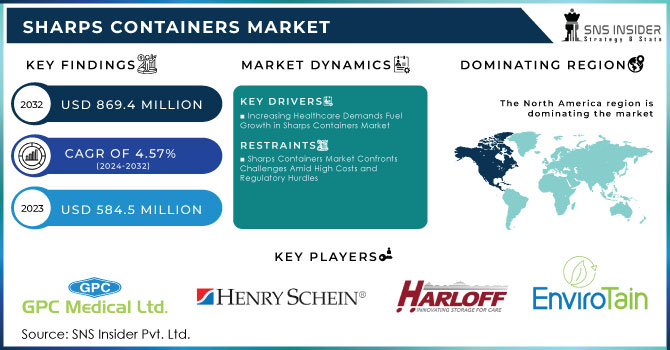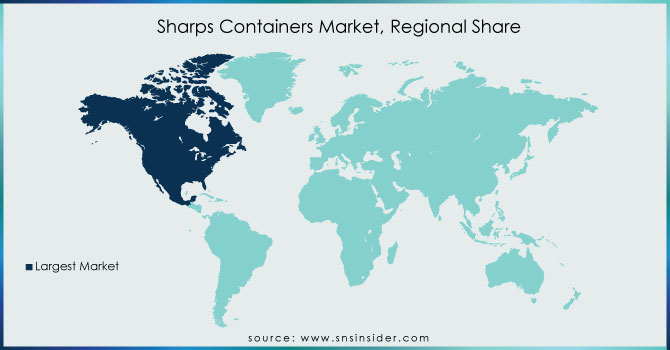Sharps Containers Market Report Scope & Overview:

To Get More Information on Sharps Containers Market - Request Sample Report
The Sharps Containers Market Size was valued at USD 584.5 Million in 2023 and is expected to reach USD 869.4 Million by 2032 and grow at a CAGR of 4.57% over the forecast period 2024-2032.
The sharps containers market is experiencing rapid growth due to the increasing demand for safe and efficient medical waste disposal solutions. Healthcare facilities, research institutions, and pharmaceutical companies generate significant amounts of medical waste, including sharp objects like needles, syringes, and lancets. These items pose a significant risk to human health and the environment if not disposed of properly. According to the CDC, approximately 385,000 healthcare workers in the United States experience needlestick and sharps-related injuries each year.
The escalating prevalence of Hospital-Acquired Infections (HAIs), primarily attributed to inadequate sanitation and safety measures, is a significant driver for the growth of the sharps container market. According to the CDC, a concerning one in 25 hospital patients is affected by at least one HAI annually. The proper disposal of medical waste in specialized containers plays a crucial role in preventing contamination and mitigating the risk of HAIs. By effectively managing medical waste, healthcare facilities can significantly reduce the spread of bacterial and microbial infections, thereby contributing to a safer patient environment.
The global surge in surgical procedures is another major factor driving the growth of the sharps container market. According to Mölnlycke Health Care AB, Europe alone witnesses an astonishing 70 million surgeries annually. The substantial amount of medical waste generated from these procedures necessitates proper disposal, increasing the demand for medical waste containers. In the United States, data from the Healthcare Cost and Utilization Project (HCUP) reveals that over 9.9 million surgeries were performed in ambulatory care settings in 2015 alone. The proper disposal of medical waste is essential to prevent the transmission of nosocomial infections, leading to a consistent preference among surgeons for specialized medical waste containers. These factors collectively contribute to the market's expansion.
Sharps containers play a crucial role in preventing accidental injuries and the spread of infectious diseases. These containers are designed to securely store and dispose of sharp medical waste, ensuring that it does not come into contact with individuals or the environment. The market for sharps containers is driven by several factors, including rising healthcare expenditure, stringent government regulations, and increased awareness about infectious diseases.
The sharps containers market is highly competitive, with a wide range of products available from various manufacturers. These containers vary in size, shape, and material, but they all share the common goal of providing a safe and effective solution for medical waste disposal. Recent advancements in the sharps containers market include the development of reusable containers, improved safety features, and the integration of smart technology.
In addition to technological advancements, there have been several recent developments in the regulatory landscape. Governments around the world are imposing stricter regulations on medical waste management to protect public health and the environment. These regulations include extended disposal timelines, free disposal programs, and government initiatives to improve medical waste management practices. In the United States, Michigan has extended the timeline for the disposal of sharps containers from 90 days to 18 months. Some communities have launched free sharps disposal programs to make it easier for residents to dispose of medical waste safely. Governments around the world are investing in infrastructure and education to improve medical waste management practices.
The sharps containers market is poised for continued growth as healthcare providers and governments prioritize safe and effective waste disposal solutions. The increasing demand for these products, coupled with advancements in technology and regulations, is expected to drive the market forward in the coming years.
BioMedical Waste Solutions offers a comprehensive guide to assist healthcare facilities and EMS professionals in the proper disposal of sharps and medical waste. The guide provides valuable information on best practices and regulations.
The Food and Drug Administration (FDA) in the United States provides comprehensive guidelines for the safe use and disposal of sharps. Similarly, the Centers for Disease Control and Prevention (CDC) offers recommendations on sharps disposal practices, tailored to healthcare facilities and individuals. At the global level, the World Health Organization (WHO) establishes guidelines for the safe management of healthcare waste, encompassing sharps disposal. Additionally, many countries have specific national or local health departments that regulate sharps disposal practices, ensuring adherence to local standards and requirements.
Market Dynamics
Drivers
-
Increasing Healthcare Demands Fuel Growth in Sharps Containers Market
The increasing demand for healthcare services, driven by rising healthcare expenditure, growing population, and aging demographics, is leading to a surge in the generation of medical waste, including sharps. Governments worldwide are imposing stricter regulations on medical waste management to protect public health and the environment, which is further driving the demand for safe and efficient disposal solutions. Moreover, the growing awareness of infectious diseases and the need for sustainable practices is increasing the demand for eco-friendly sharps containers.
Technological advancements, such as the development of reusable containers, improved safety features, and the integration of smart technology, are also contributing to the market's growth. Additionally, regulatory changes, including extended disposal timelines, free disposal programs, and government initiatives, are creating a favorable environment for the sharps containers market. These factors collectively highlight the increasing importance of safe and effective medical waste management and the growing demand for sharps containers.
Restraints
-
Sharps Containers Market Confronts Challenges Amid High Costs and Regulatory Hurdles
The sharps containers market faces several challenges, including high costs, lack of awareness, regulatory challenges, economic downturns, technological limitations, and environmental concerns. Overcoming these restraints requires investment in education, infrastructure, and sustainable practices to ensure safe and efficient medical waste disposal.
Sharps Containers Market Segmentation Analysis
By Type
Multipurpose containers dominated the market in 2023 with a 54.02% share due to their versatility, availability in various sizes and shapes, and high demand from healthcare providers, research institutes, and hospitals.
While patient room containers and phlebotomy containers serve specific needs, multipurpose containers offer a more comprehensive solution for medical waste disposal, ensuring safety and environmental protection. This versatility, coupled with their reusability, is driving their market dominance and anticipated growth.
By Container Size
The 2-4-gallon segment, favored by healthcare professionals for its versatility in handling injections, cotton swabs, and laboratory waste, dominated the market in 2023 with a 46.03% share. Its vertical drop lid design facilitates safe and convenient disposal, making it a preferred choice in hospitals and research institutions.
While larger containers, such as 4-8 gallons and above, are primarily used in settings with higher waste generation, such as hospitals and pharmaceutical companies, the 2-4 and 4-8-gallon segments are projected to experience significant growth during the forecast period. Rising awareness about the importance of proper medical waste management and the increasing variety of options offered by manufacturers are key factors contributing to this anticipated expansion.
By Usage
Reusable containers dominated the market with a 74.33% share in 2023 and experienced the fastest growth rate during the forecast period. Their superior benefits, including safety, environmental friendliness, and cost-effectiveness, make them highly desirable for pharmaceutical companies, hospitals, and research institutions.
While single-use containers are primarily employed in facilities handling biohazardous waste, their growth is expected to remain steady. Their compact size and closed lids offer protection against infections, making them suitable for research institutes and pharmaceutical companies engaged in infection-driven research.
Regional Analysis
The sharps container market is dominated by North America with a 46.32% share in 2023, driven by stringent regulations, extensive distribution networks, and a strong focus on waste management. However, the Asia Pacific region is poised to experience the most rapid growth, fueled by significant investments in manufacturing and increasing compliance with regulatory guidelines.
Europe, while showing promising growth, faces challenges due to varying levels of guideline adherence and reliance on disposable bins in lower-income countries. Despite these hurdles, countries like Germany, the U.K., and Scandinavia are contributing to the region's expansion through advancements in supply chain management and awareness campaigns.

Do You Need any Customization Research on Sharps Containers Market - Enquire Now
Key Players
The major players are GPC Medical, HenrySchein, Harloff, EnviroTain, BemishHealthcare, Cardinal Health, Becton, Dickinson and Company, BondTech Corporation, Stericycle, Thermo Fischer Scientific. and others the final reports list additional participants.
Recent Developments
In Jan 2024, Grundon, a waste management company, launched a new reusable sharps container service for the National Health Service (NHS). This initiative promotes sustainability and reduces waste.
In March 2024, Fire Prevention 24-7 in Naperville launched a free, safe, and convenient sharps disposal program. This initiative aims to reduce the risk of needlestick injuries and promote proper medical waste disposal practices.
| Report Attributes | Details |
| Market Size in 2023 | US$ 584.5 Mn |
| Market Size by 2032 | US$ 869.4 Mn |
| CAGR | CAGR of 4.57% From 2024 to 2032 |
| Base Year | 2023 |
| Forecast Period | 2024-2032 |
| Historical Data | 2020-2022 |
| Report Scope & Coverage | Market Size, Segments Analysis, Competitive Landscape, Regional Analysis, DROC & SWOT Analysis, Forecast Outlook |
| Key Segments | • By Type (Phlebotomy Containers, Patient Room Containers, Multipurpose Containers) • By Container Size (1-2 Gallons, 2-4 Gallons, 4-8 Gallons) • By Usage (Single-Use Containers, Reusable Containers) |
| Regional Analysis/Coverage | North America (US, Canada, Mexico), Europe (Eastern Europe [Poland, Romania, Hungary, Turkey, Rest of Eastern Europe] Western Europe] Germany, France, UK, Italy, Spain, Netherlands, Switzerland, Austria, Rest of Western Europe]), Asia Pacific (China, India, Japan, South Korea, Vietnam, Singapore, Australia, Rest of Asia Pacific), Middle East & Africa (Middle East [UAE, Egypt, Saudi Arabia, Qatar, Rest of Middle East], Africa [Nigeria, South Africa, Rest of Africa], Latin America (Brazil, Argentina, Colombia, Rest of Latin America) |
| Company Profiles | GPC Medical, HenrySchein, Harloff, EnviroTain, BemishHealthcare, Cardinal Health, Becton, Dickinson and Company, BondTech Corporation, Stericycle, Thermo Fischer Scientific. |
| Key Drivers | • Increasing Healthcare Demands Fuel Growth in Sharps Containers Market . |
| Market Opportunities | • Sharps Containers Market Confronts Challenges Amid High Costs and Regulatory Hurdles |

